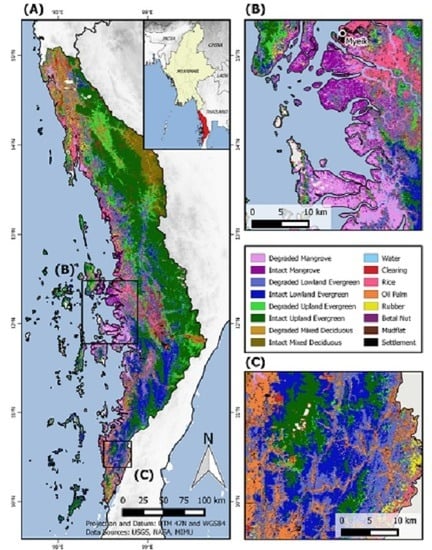Mapping Distinct Forest Types Improves Overall Forest Identification Based on Multi-Spectral Landsat Imagery for Myanmar’s Tanintharyi Region
Abstract
:1. Introduction
2. Materials and Methods
2.1. Study Area
2.2. Data and Preprocessing
2.3. Mapping Approach
3. Results
3.1. Mapping of Ecologically-Distinct Forest Types
3.2. Extent of Remaining Forest Cover
3.3. Human Land Use
3.4. Accuracy Assessment
4. Discussion
4.1. Mapping of Forest Types and Degradation Extent
4.2. Current Status of Tanintharyi’s Major Forest Ecosystems
5. Conclusions
Supplementary Materials
Acknowledgments
Author Contributions
Conflicts of Interest
Appendix A
| Landsat Scene Details | ||
|---|---|---|
| Tile | Date | Landsat 8 Identifier |
| 129_52 | 11 March 2016 | LC81290522016071 |
| 130_50 | 15 February 2016 | LC81300502016046 |
| 130_51 | 15 February 2016 | LC81300512016046 |
| 130_52 | 18 March 2016 | LC81300522016078 |
| 130_53 | 18 March 2016 | LC81300532016078 |
| 131_50 | 9 March 2016 | LC81310502016069 |
| 131_51 | 9 March 2016 | LC81310512016069 |
| 131_52 | 9 March 2016 | LC81310522016069 |
References
- De Bruyn, M.; Stelbrink, B.; Morley, R.J.; Hall, R.; Carvalho, G.R.; Cannon, C.H.; van den Bergh, G.; Meijaard, E.; Metcalfe, I.; Boitani, L.; et al. Borneo and Indochina are major evolutionary hotspots for Southeast Asian biodiversity. Syst. Biol. 2014, 63, 879–901. [Google Scholar] [CrossRef] [PubMed]
- Myers, N.; Mittermeier, R.A.; Mittermeier, C.G.; da Fonseca, G.A.B.; Kent, J. Biodiversity hotspots for conservation priorities. Nature 2000, 403, 853–858. [Google Scholar] [CrossRef] [PubMed]
- Wohlfart, C.; Wegmann, M.; Leimgruber, P. Mapping threatened dry deciduous dipterocarp forest in South-east Asia for conservation management. Trop. Conserv. Sci. 2014, 7, 597–613. [Google Scholar] [CrossRef]
- Wijedasa, L.S.; Sloan, S.; Michelakis, D.G.; Clements, G.R. Overcoming limitations with Landsat imagery for mapping of peat swamp forests in Sundaland. Remote Sens. 2012, 4, 2595–2618. [Google Scholar] [CrossRef]
- Miettinen, J.; Stibig, H.-J.; Achard, F. Remote sensing of forest degradation in Southeast Asia—Aiming for a regional view through 5–30 m satellite data. Glob. Ecol. Conserv. 2014, 2, 24–36. [Google Scholar] [CrossRef]
- Leimgruber, P.; Kelly, D.S.; Steininger, M.K.; Brunner, J.; Müller, T.; Songer, M. Forest cover change patterns in Myanmar (Burma) 1990–2000. Environ. Conserv. 2005, 32, 356–364. [Google Scholar] [CrossRef]
- Stibig, H.-J.; Stolle, F.; Dennis, R.; Feldkötter, C. Forest Cover Change in Southeast Asia. The Regional Pattern; European Commission Joint Research Centre: Ispra, Italy, 2007. [Google Scholar]
- Richards, D.R.; Friess, D.A. Rates and drivers of mangrove deforestation in Southeast Asia, 2000–2012. Proc. Natl. Acad. Sci. USA 2016, 113, 344–349. [Google Scholar] [CrossRef] [PubMed]
- Ryan, C.M.; Hill, T.; Woollen, E.; Ghee, C.; Mitchard, E.; Cassells, G.; Grace, J.; Woodhouse, I.H.; Williams, M. Quantifying small-scale deforestation and forest degradation in African woodlands using radar imagery. Glob. Chang. Biol. 2012, 18, 243–257. [Google Scholar] [CrossRef]
- Ahrends, A.; Burgess, N.D.; Milledge, S.A.H.; Bulling, M.T.; Fisher, B.; Smart, J.C.R.; Clarke, G.P.; Mhoro, B.E.; Lewis, S.L. Predictable waves of sequential forest degradation and biodiversity loss spreading from an African city. Proc. Natl. Acad. Sci. USA 2010, 107, 14556–14561. [Google Scholar] [CrossRef] [PubMed]
- Matricardi, E.A.T.; Skole, D.L.; Cochrane, M.A.; Pedlowski, M.; Chomentowski, W. Multi-temporal assessment of selective logging in the Brazilian Amazon using Landsat data. Int. J. Remote Sens. 2007, 28, 63–82. [Google Scholar] [CrossRef]
- Bhagwat, T.; Hess, A.; Horning, N.; Khaing, T.; Thein, Z.M.; Aung, K.M.; Aung, K.H.; Phyo, P.; Tun, Y.L.; Oo, A.H.; et al. Losing a jewel—Rapid declines in Myanmar’s intact forests from 2002–2014. PLoS ONE 2016. in review. [Google Scholar]
- Souza, C.M., Jr.; Roberts, D.A.; Cochrane, M.A. Combining spectral and spatial information to map canopy damage from selective logging and forest fires. Remote Sens. Environ. 2005, 98, 329–343. [Google Scholar] [CrossRef]
- Mon, M.S.; Mizoue, N.; Htun, N.Z.; Kajisa, T.; Yoshida, S. Factors affecting deforestation and forest degradation in selectively logged production forest: A case study in Myanmar. For. Ecol. Manag. 2012, 267, 190–198. [Google Scholar] [CrossRef]
- Souza, C.M., Jr.; Barreto, P. An alternative approach for detecting and monitoring selectively logged forests in the Amazon. Int. J. Remote Sens. 2000, 21, 173–179. [Google Scholar] [CrossRef]
- Suepa, T.; Qi, J.; Lawawirojwong, S.; Messina, J.P. Understanding spatio-temporal variation of vegetation phenology and rainfall seasonality in the monsoon Southeast Asia. Environ. Res. 2016, 147, 621–629. [Google Scholar] [CrossRef] [PubMed]
- Thessler, S.; Sesnie, S.; Ramos Bendaña, Z.S.; Ruokolainen, K.; Tomppo, E.; Finegan, B. Using k-nn and discriminant analyses to classify rain forest types in a Landsat TM image over northern Costa Rica. Remote Sens. Environ. 2008, 112, 2485–2494. [Google Scholar] [CrossRef]
- Sesnie, S.E.; Finegan, B.; Gessler, P.E.; Thessler, S.; Bendana, Z.R.; Smith, A.M.S. The multispectral separability of Costa Rican rainforest types with support vector machines and random forest decision trees. Int. J. Remote Sens. 2010, 31, 2885–2909. [Google Scholar] [CrossRef]
- Salovaara, K.J.; Thessler, S.; Malik, R.N.; Tuomisto, H. Classification of Amazonian primary rain forest vegetation using Landsat ETM+ satellite imagery. Remote Sens. Environ. 2005, 97, 39–51. [Google Scholar] [CrossRef]
- Fagan, M.E.; DeFries, R.S.; Sesnie, S.E.; Arroyo-Mora, J.P.; Soto, C.; Singh, A.; Townsend, P.A.; Chazdon, R.L. Mapping species composition of forests and tree plantations in northeastern Costa Rica with an integration of hyperspectral and multitemporal Landsat imagery. Remote Sens. 2015, 7, 5660–5696. [Google Scholar] [CrossRef]
- Foody, G.M.; Cutler, M.E.J. Tree biodiversity in protected and logged Bornean tropical rain forests and its measurement by satellite remote sensing. J. Biogeogr. 2003, 30, 1053–1066. [Google Scholar] [CrossRef]
- Helmer, E.H.; Goodwin, N.R.; Gond, V.; Souza, C.M., Jr.; Asner, G.P. Characterizing tropical forests with multispectral imagery. In Land Resources: Monitoring, Modeling and Mapping; Thenkabail, P.S., Ed.; CRC Press: Boca Raton, FL, USA, 2015. [Google Scholar]
- Webb, E.L.; Jachowski, N.R.A.; Phelps, J.; Friess, D.A.; Than, M.M.; Ziegler, A.D. Deforestation in the Ayeyarwady delta and the conservation implications of an internationally-engaged Myanmar. Glob. Environ. Chang. 2014, 24, 321–333. [Google Scholar] [CrossRef]
- Food and Agriculture Organization of the United Nations (FAO). Global Forest Resources Assessment; FAO: Rome, Italy, 2015. [Google Scholar]
- Woods, K. Timber Trade Flows and Actors in Myanmar: The Political Economy of Myanmar’s Timber Trade; Forest Trends: Washington, DC, USA, 2013. [Google Scholar]
- Woods, K. Commercial Agriculture Expansion in Myanmar: Links to Deforestation, Conversion Timber, and Land Conflicts; Forest Trends: Washington, DC, USA, 2015. [Google Scholar]
- Donald, P.F.; Round, P.D.; Aung, T.D.W.; Grindley, M.; Steinmetz, R.; Shwe, N.M.; Buchanan, G.M. Social reform and a growing crisis for southern Myanmar’s unique forests. Conserv. Biol. 2015, 29, 1485–1488. [Google Scholar] [CrossRef] [PubMed]
- Ministry of Environmental Conservation and Forestry (MOECAF). The Republic of the Union of Myanmar: National Biodiversity Strategy and Action Plan; Ministry of Environmental Conservation and Forestry (MOECAF): Naypyidaw, Myanmar, 2011.
- Williams, L.J.; Bunyavejchewin, S.; Baker, P.J. Deciduousness in a seasonal tropical forest in western Thailand: Interannual and intraspecific variation in timing, duration and environmental cues. Oecologia 2008, 155, 571–582. [Google Scholar] [CrossRef] [PubMed]
- Elliott, S.; Baker, P.J.; Borchert, R. Leaf flushing during the dry season: The paradox of Asian monsoon forests. Glob. Ecol. Biogeogr. 2006, 15, 248–257. [Google Scholar] [CrossRef]
- Torbick, N.; Ledoux, L.; Salas, W.; Zhao, M. Regional mapping of plantation extent using multisensor imagery. Remote Sens. 2016, 8. [Google Scholar] [CrossRef]
- R Core Team. R: A language and Environment for Statistical Computing; R Foundation for Statistical Computing: Vienna, Austria, 2014. [Google Scholar]
- Chander, G.; Markham, B.L.; Helder, D.L. Summary of current radiometric calibration coefficients for Landsat MSS, TM, ETM+, and EO-1 ALI sensors. Remote Sens. Environ. 2009, 113, 893–903. [Google Scholar] [CrossRef]
- Zhu, Z.; Wang, S.; Woodcock, C.E. Improvement and expansion of the fmask algorithm: Cloud, cloud shadow, and snow detection for Landsats 4–7, 8, and Sentinel 2 images. Remote Sens. Environ. 2015, 159, 269–277. [Google Scholar] [CrossRef]
- Zhu, Z.; Woodcock, C.E. Object-based cloud and cloud shadow detection in Landsat imagery. Remote Sens. Environ. 2012, 118, 83–94. [Google Scholar] [CrossRef]
- Riano, D.; Chuvieco, E.; Salas, J.; Aguado, I. Assessment of different topographic corrections in Landsat-TM data for mapping vegetation types (2003). IEEE Trans. Geosci. Remote Sens. 2003, 41, 1056–1061. [Google Scholar] [CrossRef]
- Hunt, R.W.G. The Reproduction of Colour, 6th ed.; John Wiley & Sons: Chichester, West Sussex, UK, 2005. [Google Scholar]
- Farr, T.G.; Rosen, P.A.; Caro, E.; Crippen, R.; Duren, R.; Hensley, S.; Kobrick, M.; Paller, M.; Rodriguez, E.; Roth, L.; et al. The shuttle radar topography mission. Rev. Geophys. 2007, 45, RG2004. [Google Scholar] [CrossRef]
- Guisan, A.; Weiss, S.B.; Weiss, A.D. GLM versus CCA spatial modeling of plant species distribution. Plant Ecol. 1999, 143, 107–122. [Google Scholar] [CrossRef]
- Plummer, M. Jags: A Program for Analysis of Bayesian Graphical Models Using Gibbs Sampling. 2003. Available online: http://citeseer.ist.psu.edu/plummer03jags.html (accessed on 18 August 2015).
- Kellner, K. Jagsui: A Wrapper around ‘Rjags’ to Streamline ‘Jags’ Analyses. Available online: http://CRAN.R-project.org/package=jagsUI (accessed on 7 September 2015).
- Liaw, A.; Wiener, M. Classification and regression by randomforest. R News 2002, 2, 18–22. [Google Scholar]
- Lillesand, T.; Kiefer, R.W.; Chipman, J. Remote Sensing and Image Interpretation; John Wiley & Sons: New York, NY, USA, 2014. [Google Scholar]
- Horning, N. Random forests: An algorithm for image classification and generation of continuous fields data sets. In Proceedings of the International Conference on Geoinformatics for Spatial Infrastructure Development in Earth and Allied Sciences, Osaka, Japan, 9–11 December 2010.
- Rodriguez-Galiano, V.F.; Ghimire, B.; Rogan, J.; Chica-Olmo, M.; Rigol-Sanchez, J.P. An assessment of the effectiveness of a random forest classifier for land-cover classification. ISPRS J. Photogramm. Remote Sens. 2012, 67, 93–104. [Google Scholar] [CrossRef]
- Cohen, J. Weighted kappa: Nominal scale agreement provision for scaled disagreement or partial credit. Psychol. Bull. 1968, 70, 213–220. [Google Scholar] [CrossRef] [PubMed]
- Foody, G.M. On the compensation for chance agreement in image classification accuracy assessment. Photogramm. Eng. Remote Sens. 1992, 58, 1459–1460. [Google Scholar]
- Foody, G.M. Harshness in image classification accuracy assessment. Int. J. Remote Sens. 2008, 29, 3137–3158. [Google Scholar] [CrossRef]
- Nishii, R.; Tanaka, S. Accuracy and inaccuracy assessments in land-cover classification. IEEE Trans. Geosci. Remote Sens. 1999, 37, 491–498. [Google Scholar] [CrossRef]
- Dong, J.; Xiao, X.; Chen, B.; Torbick, N.; Jin, C.; Zhang, G.; Biradar, C. Mapping deciduous rubber plantations through integration of PALSAR and multi-temporal Landsat imagery. Remote Sens. Environ. 2013, 134, 392–402. [Google Scholar] [CrossRef]
- Li, Z.; Fox, J.M. Mapping rubber tree growth in mainland Southeast Asia using time-series MODIS 250 m NDVI and statistical data. Appl. Geogr. 2012, 32, 420–432. [Google Scholar] [CrossRef]
- Bhatta, B. Research Methods in Remote Sensing; Springer: Dordrecht, the Netherlands, 2013. [Google Scholar]
- Hansen, M.C.; Potapov, P.V.; Moore, R.; Hancher, M.; Turubanova, S.A.; TyUKavina, A.; Thau, D.; Stehman, S.V.; Goetz, S.J.; Loveland, T.R.; et al. High-resolution global maps of 21st-century forest cover change. Science 2013, 342, 850–853. [Google Scholar] [CrossRef] [PubMed]
- Wang, C.; Myint, S. Environmental concerns of deforestation in Myanmar 2001–2010. Remote Sens. 2016. [Google Scholar] [CrossRef]
- Songer, M.; Myint, A.; Senior, B.; Defries, R.; Leimgruber, P. Spatial and temporal deforestation dynamics in protected and unprotected dry forests: A case study from Myanmar (Burma). Biodivers. Conserv. 2009, 18, 1001–1018. [Google Scholar] [CrossRef]
- Htun, N.Z.; Mizoue, N.; Kajisa, T.; Yoshida, S. Deforestation and forest degradation as measures of popa mountain park (Myanmar) effectiveness. Environ. Conserv. 2009, 36, 218–224. [Google Scholar] [CrossRef]
- Renner, S.C.; Rappole, J.H.; Leimgruber, P.; Kelly, D.S.; Shwe, N.M.; Aung, T.; Aung, M. Land cover in the northern forest complex of Myanmar: New insights for conservation. Oryx 2007, 41, 27–37. [Google Scholar] [CrossRef]
- Liu, F.-J.; Huang, C.; Pang, Y.; Li, M.; Song, D.-X.; Song, X.-P.; Channan, S.; Sexton, J.O.; Jiang, D.; Zhang, P.; et al. Assessment of the three factors affecting Myanmar’s forest cover change using Landsat and MODIS vegetation continuous fields data. Int. J. Digit. Earth 2016, 9, 562–585. [Google Scholar] [CrossRef]
- Asner, G.P.; Broadbent, E.N.; Oliveira, P.J.; Keller, M.; Knapp, D.E.; Silva, J.N. Condition and fate of logged forests in the Brazilian amazon. Proc. Natl. Acad. Sci. USA 2006, 103, 12947–12950. [Google Scholar] [CrossRef] [PubMed]
- Barbier, E.B.; Hacker, S.D.; Kennedy, C.; Koch, E.W.; Stier, A.C.; Silliman, B.R. The value of estuarine and coastal ecosystem services. Ecol. Monogr. 2011, 81, 169–193. [Google Scholar] [CrossRef]
- Baskett, J.P.C. Myanmar oil Palm Plantations: A Productivity and Sustainability Review; Fauna & Flora International: Yangon, Myanmar, 2015. [Google Scholar]
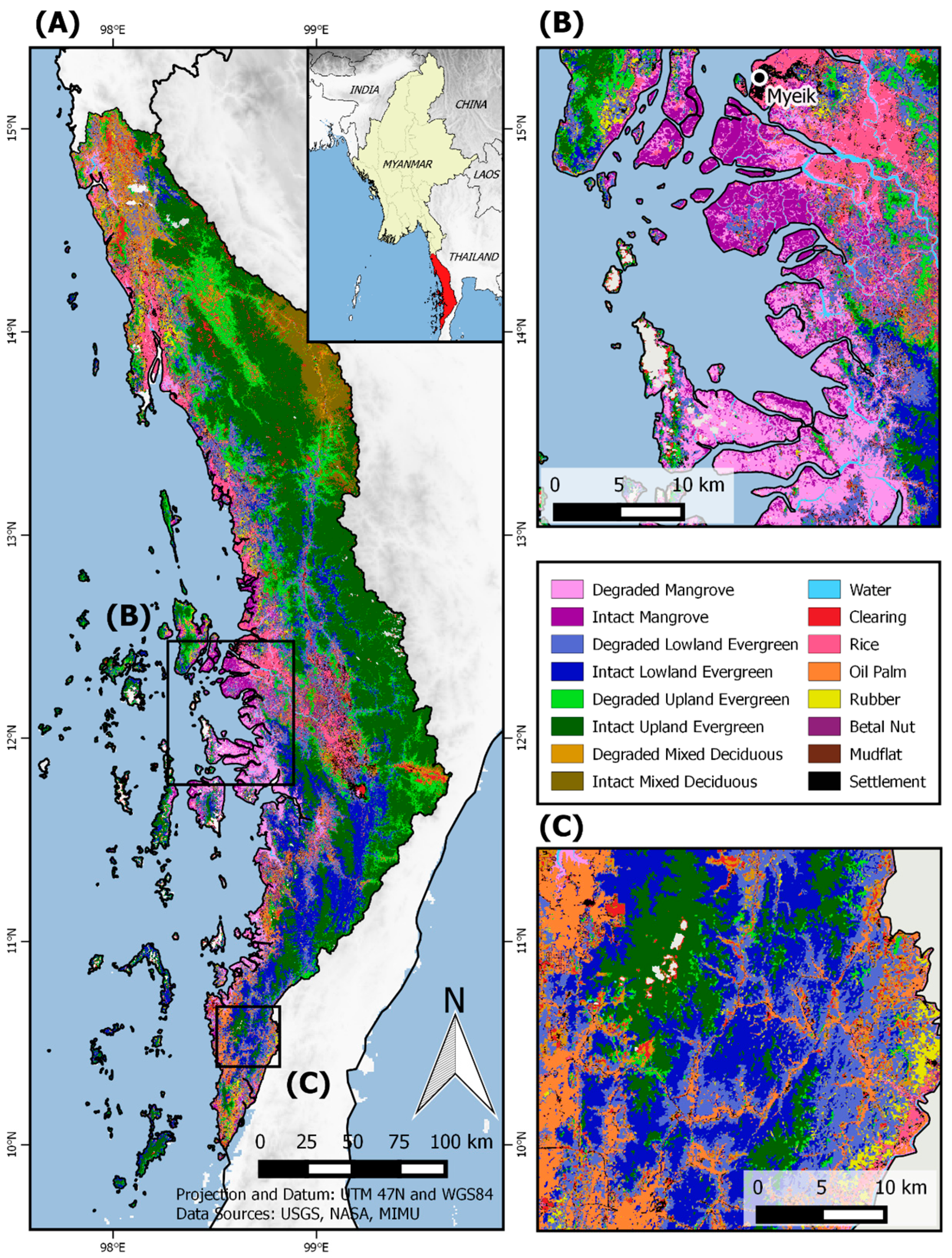
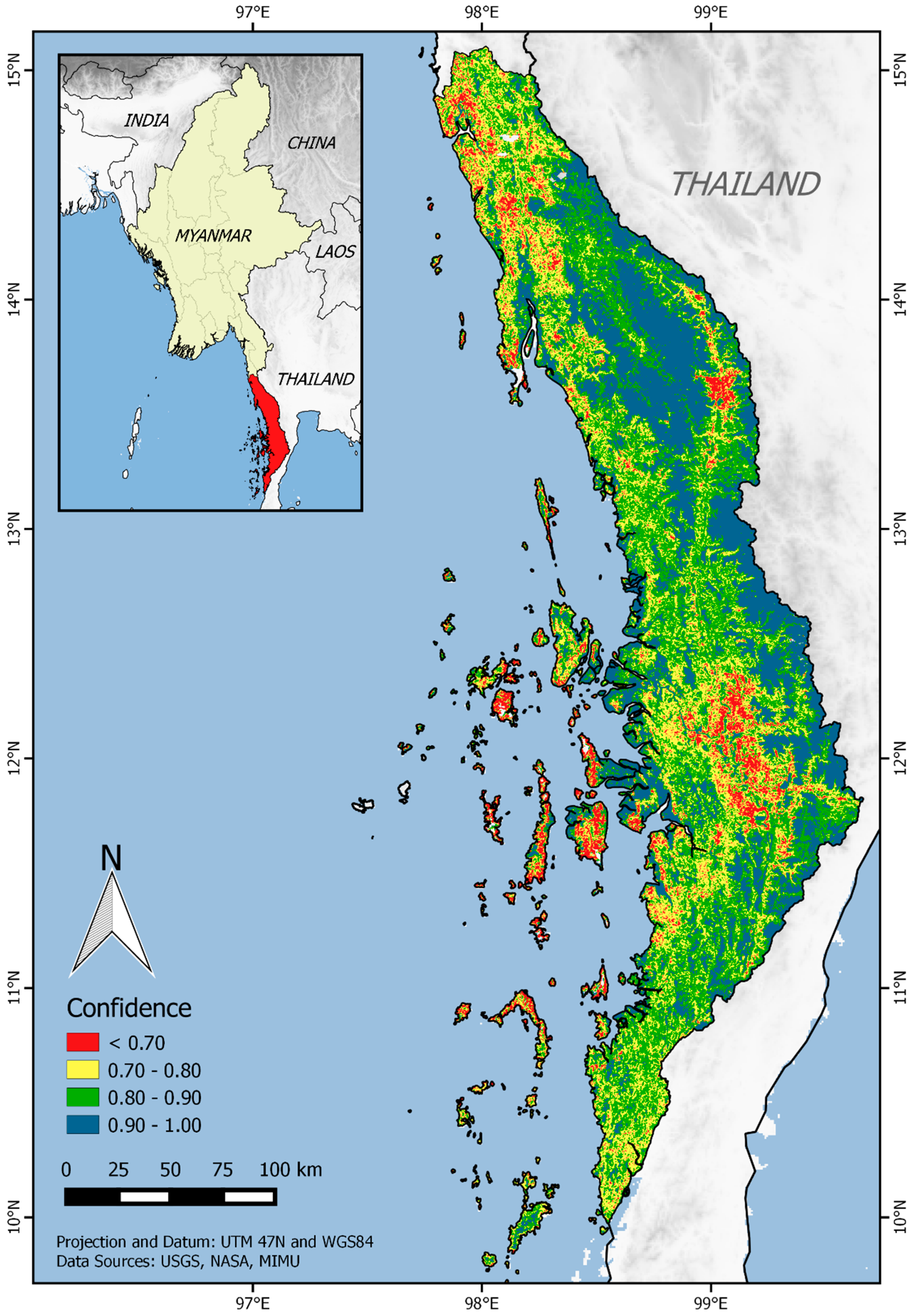
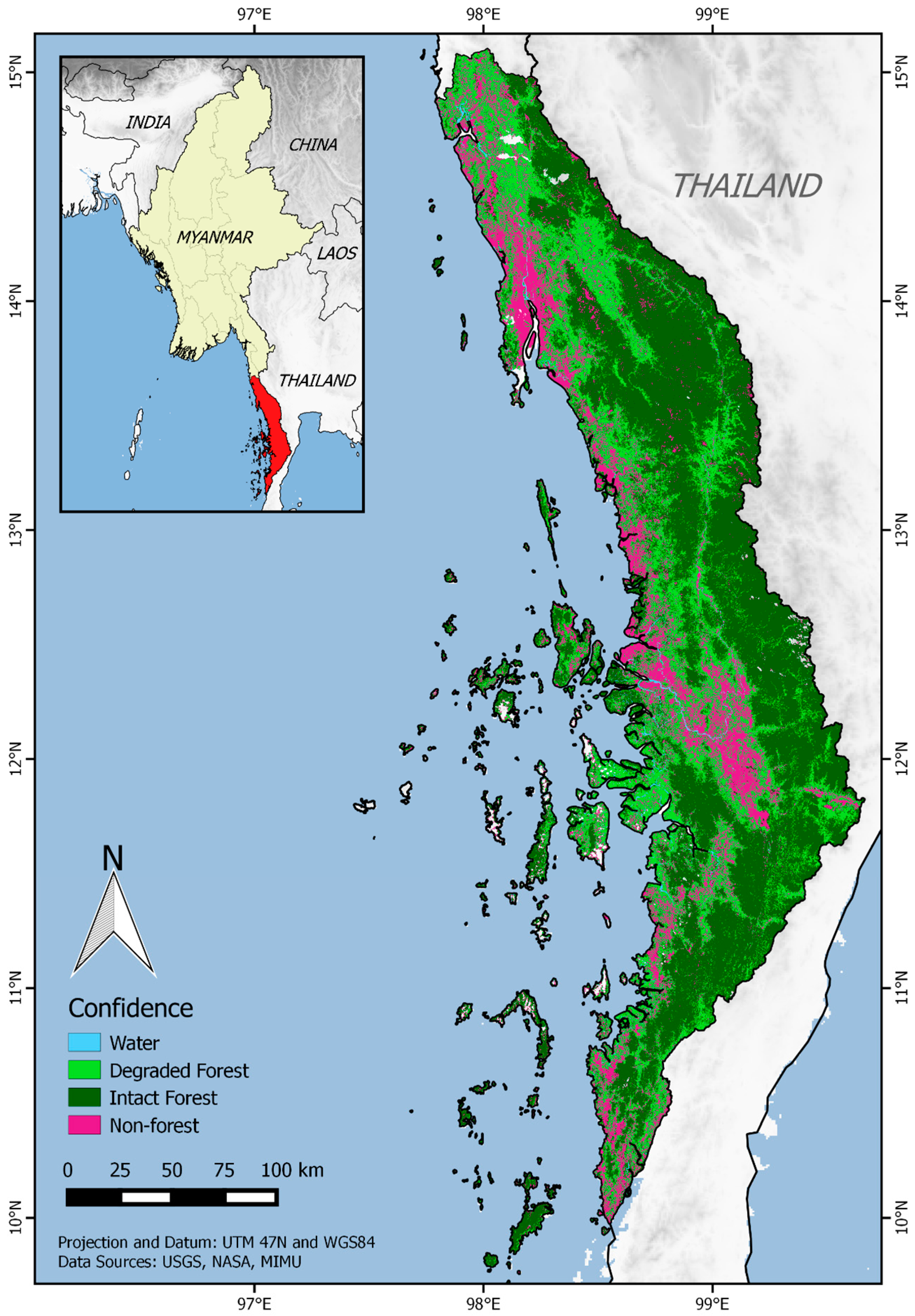
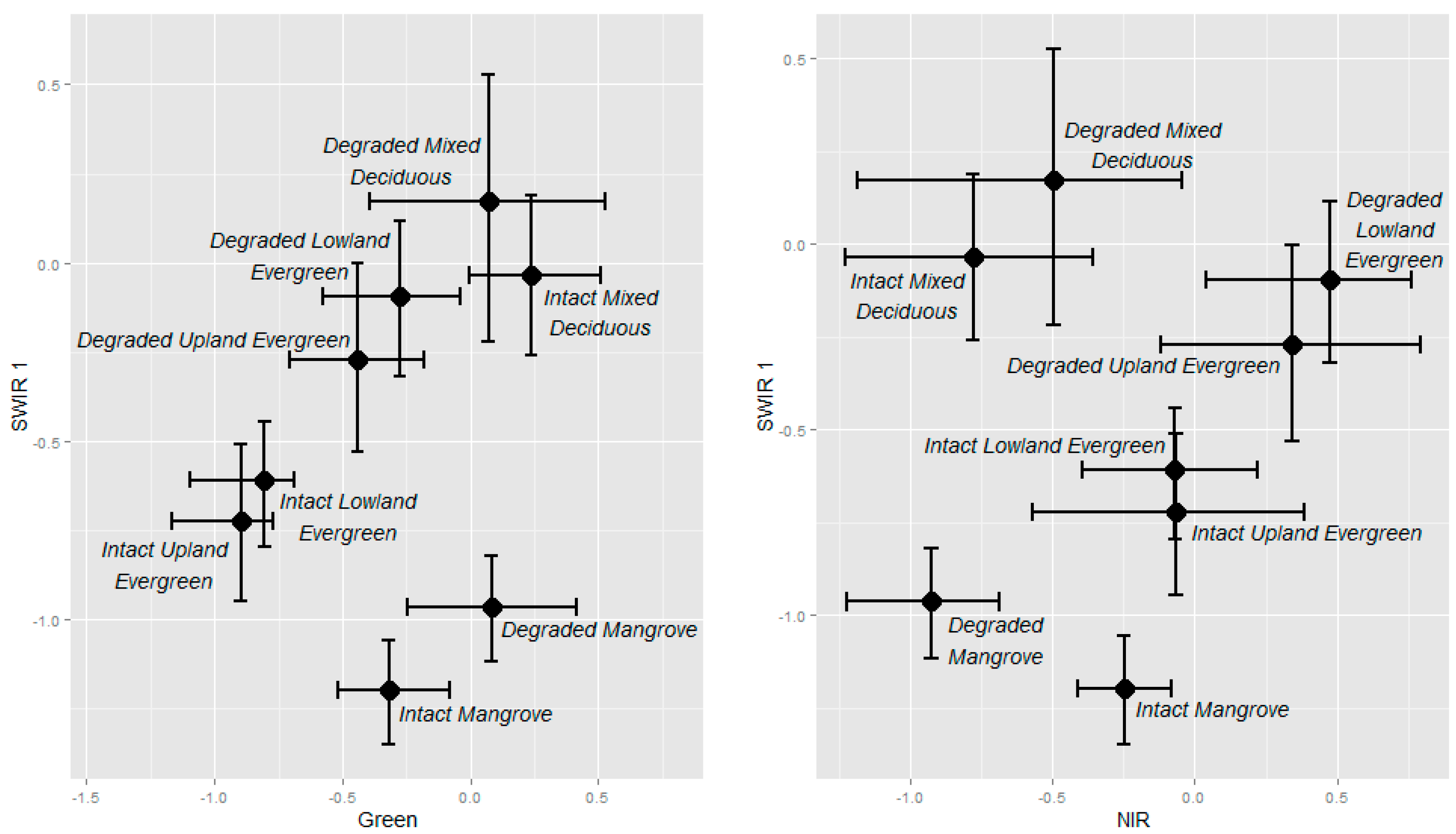
| Category | Description |
|---|---|
| Intact Upland Evergreen Forest | Canopy cover ≥80%. Elevation >200 m or on steep terrain at lower elevations. Canopy remains green year round. |
| Degraded Upland Evergreen Forest | Canopy cover <80%. Elevation >200 m or on steep terrain at lower elevations. Canopy remains green year round. |
| Intact Lowland Evergreen Forest | Canopy cover ≥80%. Elevation <200 m or on flat or level terrain. Canopy remains green year round. |
| Degraded Lowland Evergreen Forest | Canopy cover <80%. Elevation <200 m or on flat or level terrain. Canopy remains green year round. |
| Intact Mangrove Forest | Mangrove cover ≥80%. |
| Degraded Mangrove Forest | Mangrove cover <80%. Evidence of thinning visible as bare ground from above. |
| Intact Mixed Deciduous Forest | Canopy cover ≥80%. Mixture of trees with and without leaves during dry season. |
| Degraded Mixed Deciduous Forest | Canopy cover ≥80%. Mixture of trees with and without leaves during dry season. |
| Oil Palm Plantation | Mature oil palm. Oil palm coverage >50%. |
| Rubber Plantation | Mature rubber plantation. Rubber coverage >50%. |
| Betal Nut Garden/Plantation | Mature betal nut garden, plantation, or planting in forest |
| Settlement | Areas with interspersed to complete coverage of buildings and man-made structures. |
| Rice | Rice |
| Mudflat | Coastal and estuarine mudflats |
| Bare Ground/Clearing | Exposed soil and recent clearings with grassy or low herbaceous vegetation cover |
| Water | Ocean, rivers, lakes, reservoirs, flooded areas. |
| Land Cover | Area (km2) | Percent of Total |
|---|---|---|
| Degraded Mangrove | 1604 | 4.0 |
| Intact Mangrove | 826 | 2.1 |
| Degraded Lowland Evergreen | 4141 | 10.4 |
| Intact Lowland Evergreen | 4580 | 11.5 |
| Degraded Upland Evergreen | 4624 | 11.6 |
| Intact Upland Evergreen | 12,456 | 31.2 |
| Degraded Mixed Deciduous | 2295 | 5.8 |
| Intact Mixed Deciduous | 2046 | 5.1 |
| Bare Ground/Clearing | 1529 | 3.8 |
| Rice | 1542 | 3.9 |
| Oil Palm Plantation | 1365 | 3.4 |
| Rubber Plantation | 1275 | 2.1 |
| Betal Nut Garden/Plantation | 821 | 2.2 |
| Settlement | 866 | 3.0 |
| Total | 39,897 | 100.0 |
| Reference Points | ||||||||||||||||
|---|---|---|---|---|---|---|---|---|---|---|---|---|---|---|---|---|
| wa | dv | iv | dl | il | du | iu | dm | im | cl | ri | oi | ru | be | mu | se | |
| wa | 25 | 0 | 0 | 0 | 0 | 0 | 0 | 0 | 0 | 0 | 0 | 0 | 0 | 0 | 0 | 0 |
| dv | 0 | 22 | 4 | 0 | 0 | 0 | 0 | 0 | 0 | 0 | 1 | 0 | 0 | 0 | 0 | 0 |
| iv | 0 | 1 | 21 | 0 | 0 | 0 | 0 | 0 | 0 | 0 | 0 | 0 | 0 | 0 | 0 | 0 |
| dl | 0 | 0 | 0 | 18 | 1 | 1 | 0 | 1 | 2 | 2 | 0 | 0 | 0 | 2 | 0 | 0 |
| il | 0 | 0 | 0 | 3 | 20 | 1 | 1 | 1 | 0 | 0 | 0 | 0 | 0 | 0 | 0 | 0 |
| du | 0 | 0 | 0 | 0 | 1 | 14 | 1 | 2 | 1 | 0 | 0 | 0 | 0 | 0 | 0 | 0 |
| iu | 0 | 0 | 0 | 0 | 2 | 4 | 23 | 1 | 0 | 0 | 0 | 0 | 0 | 0 | 0 | 0 |
| dm | 0 | 0 | 0 | 0 | 0 | 1 | 0 | 11 | 6 | 4 | 0 | 1 | 0 | 2 | 0 | 0 |
| im | 0 | 0 | 0 | 0 | 0 | 2 | 0 | 9 | 16 | 1 | 0 | 0 | 0 | 0 | 0 | 0 |
| cl | 0 | 0 | 0 | 0 | 0 | 0 | 0 | 0 | 0 | 13 | 0 | 0 | 0 | 0 | 0 | 3 |
| ri | 0 | 1 | 0 | 0 | 0 | 0 | 0 | 0 | 0 | 2 | 21 | 0 | 0 | 0 | 3 | 3 |
| oi | 0 | 1 | 0 | 1 | 1 | 0 | 0 | 0 | 0 | 0 | 0 | 22 | 2 | 2 | 0 | 0 |
| ru | 0 | 0 | 0 | 1 | 0 | 0 | 0 | 0 | 0 | 0 | 1 | 0 | 22 | 0 | 0 | 0 |
| be | 0 | 0 | 0 | 1 | 0 | 2 | 0 | 0 | 0 | 0 | 2 | 0 | 0 | 18 | 0 | 0 |
| mu | 0 | 0 | 0 | 0 | 0 | 0 | 0 | 0 | 0 | 0 | 0 | 0 | 0 | 0 | 22 | 0 |
| se | 0 | 0 | 0 | 1 | 0 | 0 | 0 | 0 | 0 | 3 | 0 | 2 | 1 | 1 | 0 | 19 |
| Producer’s Accuracies: | ||||||||||||||||
| 1.00 | 0.88 | 0.84 | 0.72 | 0.80 | 0.56 | 0.92 | 0.44 | 0.64 | 0.52 | 0.84 | 0.88 | 0.88 | 0.72 | 0.88 | 0.76 | |
| User’s Accuracies: | ||||||||||||||||
| 1.00 | 0.81 | 0.95 | 0.67 | 0.77 | 0.74 | 0.77 | 0.44 | 0.57 | 0.81 | 0.70 | 0.76 | 0.92 | 0.78 | 1.00 | 0.70 | |
© 2016 by the authors; licensee MDPI, Basel, Switzerland. This article is an open access article distributed under the terms and conditions of the Creative Commons Attribution (CC-BY) license (http://creativecommons.org/licenses/by/4.0/).
Share and Cite
Connette, G.; Oswald, P.; Songer, M.; Leimgruber, P. Mapping Distinct Forest Types Improves Overall Forest Identification Based on Multi-Spectral Landsat Imagery for Myanmar’s Tanintharyi Region. Remote Sens. 2016, 8, 882. https://doi.org/10.3390/rs8110882
Connette G, Oswald P, Songer M, Leimgruber P. Mapping Distinct Forest Types Improves Overall Forest Identification Based on Multi-Spectral Landsat Imagery for Myanmar’s Tanintharyi Region. Remote Sensing. 2016; 8(11):882. https://doi.org/10.3390/rs8110882
Chicago/Turabian StyleConnette, Grant, Patrick Oswald, Melissa Songer, and Peter Leimgruber. 2016. "Mapping Distinct Forest Types Improves Overall Forest Identification Based on Multi-Spectral Landsat Imagery for Myanmar’s Tanintharyi Region" Remote Sensing 8, no. 11: 882. https://doi.org/10.3390/rs8110882
APA StyleConnette, G., Oswald, P., Songer, M., & Leimgruber, P. (2016). Mapping Distinct Forest Types Improves Overall Forest Identification Based on Multi-Spectral Landsat Imagery for Myanmar’s Tanintharyi Region. Remote Sensing, 8(11), 882. https://doi.org/10.3390/rs8110882






